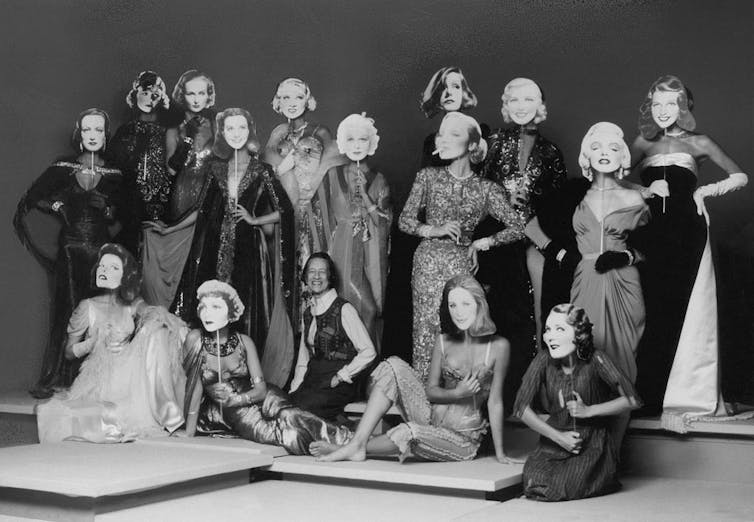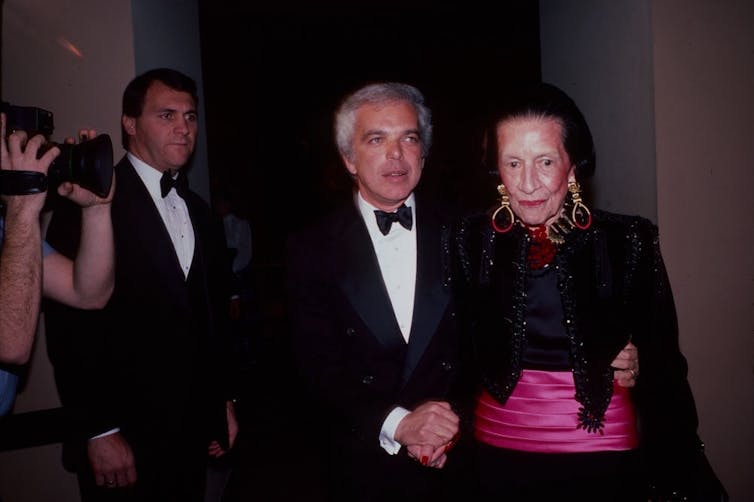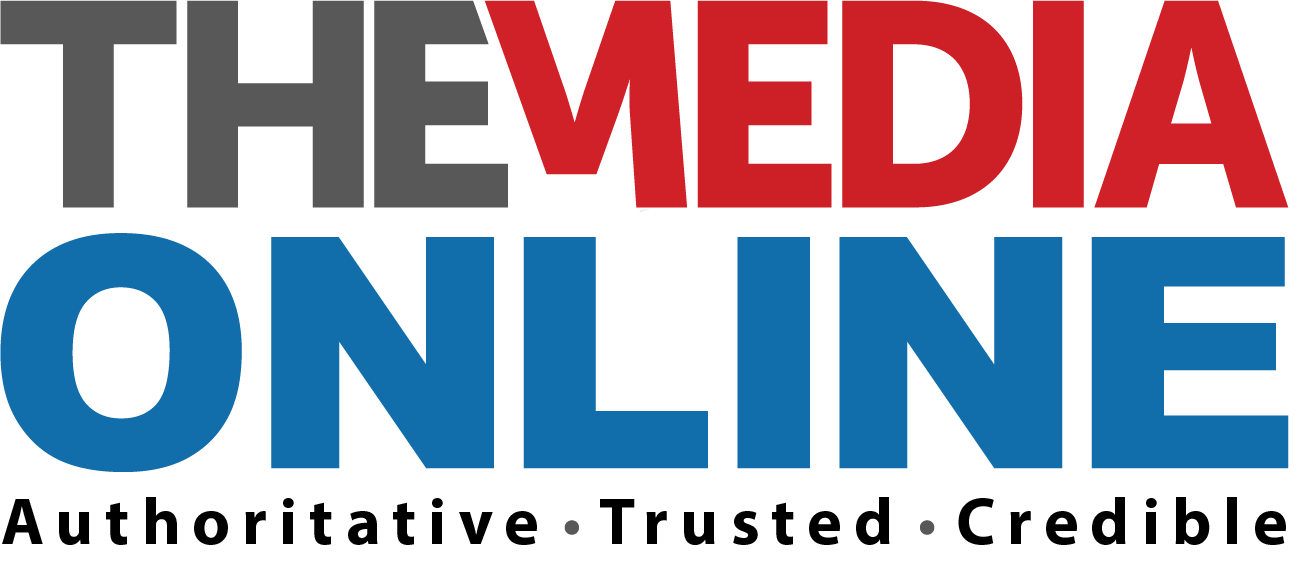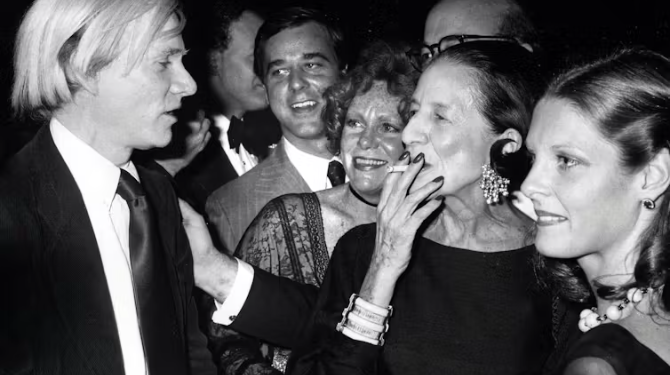The annual Met Gala in New York City is a dazzling collision of celebrity, fashion and media frenzy.
The event is ostensibly a fundraiser for the Metropolitan Museum of Art’s Costume Institute, which houses a vast collection of historical costumes and fashion artifacts.
But for many people, it’s that time of year when their social media feeds become awash with posts, stories and live streams of A-list actors, musicians and influencers ascending the iconic steps of the Metropolitan Museum of Art to showcase their elaborate outfits.

Neilson Barnard/MG24/Getty Images for The Met Museum/Vogue
The gala has come a long way since its early days as an intimate fundraising event for the local fashion industry and New York’s old-guard elite.
Through my research at the Met’s Thomas J. Watson Library, I discovered the ways in which a former fashion editor named Diana Vreeland elevated this formerly stuffy charity ball into a global media sensation.
A low-key affair
Philanthropist and arts patron Irene Lewisohn launched the Museum of Costume Art in 1937 to promote the preservation and study of historical clothing. In 1946, New York fashion publicist Eleanor Lambert helped bring the museum’s collection under the purview of the Metropolitan Museum of Art, with the caveat that it would operate independently of the museum’s budget. It was then renamed the Costume Institute.

Erwin Blumenfeld/Condé Nast via Getty Images
In 1948, Lambert organised the inaugural gala to raise funds for the institute. The following year, Lord & Taylor president Dorothy Shaver established a formal management structure for both the institute and its annual gala, streamlined operations, and helped burnish the reputation of the fledgling institution among New York’s social elite. During her tenure, gala revenues climbed steadily, from US$31,723 in 1949 to $118,775 in 1958 – roughly $1.3 million in today’s dollars.
The Met Gala that Shaver shaped looked similar, in many ways, to today’s: There was a theme, a formal dinner, live entertainment and a fashion parade that attendees could participate in. There were also a photographers row, where guests could be snapped by famed fashion photographers for a fee, and raffles with department store prizes.
After Shaver’s death in 1958, department store executives continued to steer the gala, but attendance and revenue waned. In 1961, in an effort to cut costs and revive interest, the event was moved into the museum itself.
The gala needed a reinvention. Soon, it would get one.
Vreeland’s vision
Diana Vreeland took the reins of the Met Gala in 1973.
She’d had a storied career in fashion journalism, including stints as fashion editor of Harper’s Bazaar and editor-in-chief of Vogue.
Vreeland, however, understood that in order for the gala to grow, it needed to become a newsworthy event that would be of interest to those who might not even attend the gala itself. So she selected spectacular, sometimes controversial themes that would generate interest from the press.
Vreeland’s first exhibition in 1973 was bold: a tribute to a single designer, Cristóbal Balenciaga.
“The World of Balenciaga” was funded by the Spanish government, Iberia Airlines and five Spanish banks – a controversial move, considering Spain was still under Francisco Franco’s dictatorship. The show featured Franco’s granddaughter’s wedding dress as one of the central pieces.
Some curators also bristled at Vreeland’s unorthodox approach to exhibition planning, such as blurring time periods, displaying clothes without providing historical context and prioritizing beauty over scholarship.
“She knows fashion and who wore it,” one former museum official said, “but she doesn’t know history.”
Nonetheless, critics deemed the gala and its accompanying exhibition a huge success. American designer Stan Herman declared that the garments “belong in a museum, like good paintings.”
In the coming years, Vreeland’s other themes included “Romantic and Glamorous Hollywood Design,” “The ‘10s, ’20s and ’30s,” and “American Women of Style.” The latter was accompanied by a Vogue magazine spread starring actress and model Marisa Berenson, who channeled iconic American “it girls” like Irene Castle, Consuelo Vanderbilt and Josephine Baker.

Buzz and pizzazz
Before Vreeland, coverage of the gala was limited to society pages and publications like Women’s Wear Daily.
Vreeland knew how to generate buzz because she thought like an editor. She also knew how to charm the press. Vreeland popularized words like “pizzazz,” “splendeur” and “deeveen.” She told tales of discovering model and actress Lauren Bacall and the work of fashion designer Roy Halston. She regaled reporters with stories of allegedly visiting Buffalo Bill in Wyoming.
Under Vreeland’s leadership, media coverage of the gala and exhibitions exploded, with articles appearing in The New York Times, The New Yorker, New York Magazine, People, Interview, Le Figaro, Le Monde, Revista Hola!, ABC de las Americas, Il Tempo, Paris Herald Tribune and Tokyo’s High Fashion, among others. During her tenure, she also opened the doors to reporters and photographers so they could cover the night of the event.
In an interview with Women’s Wear Daily she said, “I am an entertainer. And I believe in wit, and good nature, and laughter.”
Corporate controversies
With “The World of Balenciaga,” Vreeland also pioneered the use of corporate sponsorships to finance the exhibitions and parties. In 1982, Pierre Cardin Management funded “La Belle Époque,” a Met Gala theme associated with the relaunch of the famed Paris restaurant Maxim’s, in which Cardin had invested.
In 1983, Vreeland courted controversy again with the first exhibition honoring a living designer — Yves Saint Laurent — underwritten by the Pierre Bergé Foundation. Bergé was Saint Laurent’s life and business partner.
The show was launched amid rumors of the designer’s declining health and growing criticism of the museum being exploited as a publicity platform.
“One day the god of the Temple of Dendur will cry: ‘I am not on earth to share a museum with a bunch of fashion freaks!’” critic John Heilpern groused in the East Side Express.
The following year, Ralph Lauren became the central sponsor and guest of honor for “Man and the Horse.”

Sonia Moskowitz/Getty Images
The Met set
Under Vreeland, a new kind of guest list also emerged.
The rise of celebrity culture in the 1960s gave birth to the “jet set” – beautiful people whose fame transcended traditional society circles.
Vreeland embraced this shift. She made space at the gala for the likes of Andy Warhol, Bianca and Mick Jagger, Halston and his Halstonettes, David Bowie, Cher, Diana Ross, Warren Beatty and Jack Nicholson.
Their presence helped transform the gala from society soirée to pop culture phenomenon.
After Vreeland’s death in 1989, the event lost some its splendor under the guidance of museum curators. Women’s Wear Daily columnist Aileen Mehle later lamented the decline, writing that the event had become “a far cry from the dear old Diana Vreeland days when that fashion oracle called the Costume Institute’s shots, and elegance and anticipation abounded.”
In the late 1990s, however, the museum curators who had run the event since Vreeland’s death ceded control back to the fashion industry. High-end brands like Chanel, Versace and Christian Dior sponsored the Met Gala, while fashion editors such as Liz Tilberis and Anna Wintour chaired the event.
By channeling Vreeland’s vision, they were able to turn the gala into the global media spectacle it is today, which now thrives in an era of social media and global branding.
This year’s theme, “Superfine: Tailoring Black Styles,” is co-chaired by rapper-producer Pharrell Williams, who is also the artistic director of Menswear at Louis Vuitton. The LVMH conglomerate – Moët Hennessy Louis Vuitton – is the sponsor, showing how the gala continues to operate as a platform where corporate branding, celebrity culture and high culture converge.![]()

Dimitrios Kambouris/Getty Images
Elizabeth Castaldo Lundén, SweAmfo/ASF Research Fellow at USC School of Cinematic Arts | Fulbright Scholar, University of Southern California
This article is republished from The Conversation under a Creative Commons license. Read the original article.
The annual Met Gala in New York City is a dazzling collision of celebrity, fashion and media frenzy.
The event is ostensibly a fundraiser for the Metropolitan Museum of Art’s Costume Institute, which houses a vast collection of historical costumes and fashion artifacts.
But for many people, it’s that time of year when their social media feeds become awash with posts, stories and live streams of A-list actors, musicians and influencers ascending the iconic steps of the Metropolitan Museum of Art to showcase their elaborate outfits.

Neilson Barnard/MG24/Getty Images for The Met Museum/Vogue
The gala has come a long way since its early days as an intimate fundraising event for the local fashion industry and New York’s old-guard elite.
Through my research at the Met’s Thomas J. Watson Library, I discovered the ways in which a former fashion editor named Diana Vreeland elevated this formerly stuffy charity ball into a global media sensation.
A low-key affair
Philanthropist and arts patron Irene Lewisohn launched the Museum of Costume Art in 1937 to promote the preservation and study of historical clothing. In 1946, New York fashion publicist Eleanor Lambert helped bring the museum’s collection under the purview of the Metropolitan Museum of Art, with the caveat that it would operate independently of the museum’s budget. It was then renamed the Costume Institute.

Erwin Blumenfeld/Condé Nast via Getty Images
In 1948, Lambert organised the inaugural gala to raise funds for the institute. The following year, Lord & Taylor president Dorothy Shaver established a formal management structure for both the institute and its annual gala, streamlined operations, and helped burnish the reputation of the fledgling institution among New York’s social elite. During her tenure, gala revenues climbed steadily, from US$31,723 in 1949 to $118,775 in 1958 – roughly $1.3 million in today’s dollars.
The Met Gala that Shaver shaped looked similar, in many ways, to today’s: There was a theme, a formal dinner, live entertainment and a fashion parade that attendees could participate in. There were also a photographers row, where guests could be snapped by famed fashion photographers for a fee, and raffles with department store prizes.
After Shaver’s death in 1958, department store executives continued to steer the gala, but attendance and revenue waned. In 1961, in an effort to cut costs and revive interest, the event was moved into the museum itself.
The gala needed a reinvention. Soon, it would get one.
Vreeland’s vision
Diana Vreeland took the reins of the Met Gala in 1973.
She’d had a storied career in fashion journalism, including stints as fashion editor of Harper’s Bazaar and editor-in-chief of Vogue.
Vreeland, however, understood that in order for the gala to grow, it needed to become a newsworthy event that would be of interest to those who might not even attend the gala itself. So she selected spectacular, sometimes controversial themes that would generate interest from the press.
Vreeland’s first exhibition in 1973 was bold: a tribute to a single designer, Cristóbal Balenciaga.
“The World of Balenciaga” was funded by the Spanish government, Iberia Airlines and five Spanish banks – a controversial move, considering Spain was still under Francisco Franco’s dictatorship. The show featured Franco’s granddaughter’s wedding dress as one of the central pieces.
Some curators also bristled at Vreeland’s unorthodox approach to exhibition planning, such as blurring time periods, displaying clothes without providing historical context and prioritizing beauty over scholarship.
“She knows fashion and who wore it,” one former museum official said, “but she doesn’t know history.”
Nonetheless, critics deemed the gala and its accompanying exhibition a huge success. American designer Stan Herman declared that the garments “belong in a museum, like good paintings.”
In the coming years, Vreeland’s other themes included “Romantic and Glamorous Hollywood Design,” “The ‘10s, ’20s and ’30s,” and “American Women of Style.” The latter was accompanied by a Vogue magazine spread starring actress and model Marisa Berenson, who channeled iconic American “it girls” like Irene Castle, Consuelo Vanderbilt and Josephine Baker.

Buzz and pizzazz
Before Vreeland, coverage of the gala was limited to society pages and publications like Women’s Wear Daily.
Vreeland knew how to generate buzz because she thought like an editor. She also knew how to charm the press. Vreeland popularized words like “pizzazz,” “splendeur” and “deeveen.” She told tales of discovering model and actress Lauren Bacall and the work of fashion designer Roy Halston. She regaled reporters with stories of allegedly visiting Buffalo Bill in Wyoming.
Under Vreeland’s leadership, media coverage of the gala and exhibitions exploded, with articles appearing in The New York Times, The New Yorker, New York Magazine, People, Interview, Le Figaro, Le Monde, Revista Hola!, ABC de las Americas, Il Tempo, Paris Herald Tribune and Tokyo’s High Fashion, among others. During her tenure, she also opened the doors to reporters and photographers so they could cover the night of the event.
In an interview with Women’s Wear Daily she said, “I am an entertainer. And I believe in wit, and good nature, and laughter.”
Corporate controversies
With “The World of Balenciaga,” Vreeland also pioneered the use of corporate sponsorships to finance the exhibitions and parties. In 1982, Pierre Cardin Management funded “La Belle Époque,” a Met Gala theme associated with the relaunch of the famed Paris restaurant Maxim’s, in which Cardin had invested.
In 1983, Vreeland courted controversy again with the first exhibition honoring a living designer — Yves Saint Laurent — underwritten by the Pierre Bergé Foundation. Bergé was Saint Laurent’s life and business partner.
The show was launched amid rumors of the designer’s declining health and growing criticism of the museum being exploited as a publicity platform.
“One day the god of the Temple of Dendur will cry: ‘I am not on earth to share a museum with a bunch of fashion freaks!’” critic John Heilpern groused in the East Side Express.
The following year, Ralph Lauren became the central sponsor and guest of honor for “Man and the Horse.”

Sonia Moskowitz/Getty Images
The Met set
Under Vreeland, a new kind of guest list also emerged.
The rise of celebrity culture in the 1960s gave birth to the “jet set” – beautiful people whose fame transcended traditional society circles.
Vreeland embraced this shift. She made space at the gala for the likes of Andy Warhol, Bianca and Mick Jagger, Halston and his Halstonettes, David Bowie, Cher, Diana Ross, Warren Beatty and Jack Nicholson.
Their presence helped transform the gala from society soirée to pop culture phenomenon.
After Vreeland’s death in 1989, the event lost some its splendor under the guidance of museum curators. Women’s Wear Daily columnist Aileen Mehle later lamented the decline, writing that the event had become “a far cry from the dear old Diana Vreeland days when that fashion oracle called the Costume Institute’s shots, and elegance and anticipation abounded.”
In the late 1990s, however, the museum curators who had run the event since Vreeland’s death ceded control back to the fashion industry. High-end brands like Chanel, Versace and Christian Dior sponsored the Met Gala, while fashion editors such as Liz Tilberis and Anna Wintour chaired the event.
By channeling Vreeland’s vision, they were able to turn the gala into the global media spectacle it is today, which now thrives in an era of social media and global branding.
This year’s theme, “Superfine: Tailoring Black Styles,” is co-chaired by rapper-producer Pharrell Williams, who is also the artistic director of Menswear at Louis Vuitton. The LVMH conglomerate – Moët Hennessy Louis Vuitton – is the sponsor, showing how the gala continues to operate as a platform where corporate branding, celebrity culture and high culture converge.![]()

Dimitrios Kambouris/Getty Images
Elizabeth Castaldo Lundén, SweAmfo/ASF Research Fellow at USC School of Cinematic Arts | Fulbright Scholar, University of Southern California
This article is republished from The Conversation under a Creative Commons license. Read the original article.














